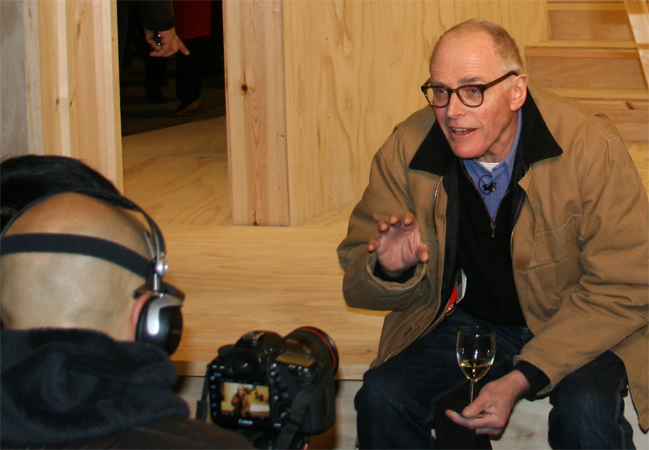Richard Wentworth is the eminence not-so-grise of British contemporary art. The perpetually youthful sculptor’s activities span an extraordinary range of eras and ideas: serving as a teenage assistant to Henry Moore in the Sixties; building sets for Roxy Music in the Seventies; kick-starting the New British Sculpture movement in the Eighties with Tony Cragg and Richard Deacon; masterminding the now legendary "Goldsmiths Course" which launched the YBA generation, alongside Jon Thompson and Michael Craig-Martin.
Beyond all this, Wentworth is a tireless social and intellectual catalyst, a man who knows everybody and has his finger in an amazing number of pies. Now 65, an age when most people are thinking of retiring – if they haven’t already done so – Wentworth (pictured below) is out there in a way that would exhaust a man half his age.
 Now we have a double opportunity to see what this power-behind-the-scenes has been up to of late, with an exhibition of current work at the Lisson Gallery and a major installation – Black Maria – which opened last night in the Crossing, the monumental public space in the new Central Saint Martins building in King's Cross.
Now we have a double opportunity to see what this power-behind-the-scenes has been up to of late, with an exhibition of current work at the Lisson Gallery and a major installation – Black Maria – which opened last night in the Crossing, the monumental public space in the new Central Saint Martins building in King's Cross.
If you haven’t been to the spectacular new CSM, you should get there before the surrounding area (until recently a Piranesi-esque wasteland of abandoned gasometers and railway sidings) becomes the new Covent Garden. While you need security clearance to enter the college’s magnificent atrium, the Crossing, at the south end, is open to the public 24 hours a day. Wentworth describes it as "a narthex... one of those cathedral-esque, railwaystation-ish places we don’t have a name for." It’s a space laden with a sense of urban exploration and encounter, which Wentworth’s piece plays on and subverts.
"I’m interested in the energy and patterns of the city," he says. "What makes some corners magnetic to rubbish, and others famous for road accidents."
'They saw this as being like a kind of visual ping-pong table'
Named after a temporary film studio used by Thomas Edison, which revolved towards the sun – an image that seems to Wentworth "very connected with looking and seeing" – Black Maria looks like a theatre, twisted and turned in on itself, executed in unprimed timber and plywood. It appears at once festive, provisional and balsawood-fragile, framed against the massively solid surrounding building.
"At the moment the pedestrian traffic here is mostly students. But in the coming months, as other things start to open, the space will start to work differently. It’ll become, not quite like the Tate Turbine Hall, but that lovely English word, a thoroughfare. So I proposed that we block it, make trouble in it. We don’t tell anyone what this thing is, then we watch what happens."
At the private view, people sitting on the brilliantly lit tiers inside watched people moving in the relative dimness outside – a reversal of what we expect to encounter in a theatre. It appears at first like one of Wentworth’s signature works, in which everyday objects are re-encountered and redefined, but seen on a massive scale. Yet rather than being simply a very large sculpture, it’s intended for practical use. A wooden panel at the front slides down to form a screen which can be viewed from inside and out. Anyone can apply to use the structure for film, talks and performances, turning it into what Wentworth sees as both an "inhabitable billboard" and a "village hall" for the area.
 Black Maria is informed by Wentworth’s 40 years' experience of living in King's Cross, seeing the area transformed from post-Victorian dereliction to its current position of burgeoning global eminence. Yet he’s at pains to point out he didn’t design the structure, much less build it, himself, but worked with GRUPPE, a team of three Swiss architects.
Black Maria is informed by Wentworth’s 40 years' experience of living in King's Cross, seeing the area transformed from post-Victorian dereliction to its current position of burgeoning global eminence. Yet he’s at pains to point out he didn’t design the structure, much less build it, himself, but worked with GRUPPE, a team of three Swiss architects.
"For three months we’ve been engaged in a visual conversation," says Wentworth. "I had a more or less idle idea of having two audiences on both sides of a screen, with passers-by seeing these people in sections. We saw this as being like a kind of visual ping-pong table. What we’ve ended up with is half of that. But I held back from commenting on what they were doing. That would have made me like the person who’s fussing about their back extension."
Yet in 28 days time, the structure will be no more. "That is a legal requirement," says Wentworth. "By the end there’ll be hundreds of people desperate to use it. So it won’t be thrown away, but it probably won’t stay here."










![SEX MONEY RACE RELIGION [2016] by Gilbert and George. Installation shot of Gilbert & George 21ST CENTURY PICTURES Hayward Gallery](/sites/default/files/styles/thumbnail_125_x_125_/public/mastimages/Gilbert%20%26%20George_%2021ST%20CENTURY%20PICTURES.%20SEX%20MONEY%20RACE%20RELIGION%20%5B2016%5D.%20Photo_%20Mark%20Blower.%20Courtesy%20of%20the%20Gilbert%20%26%20George%20and%20the%20Hayward%20Gallery._0.jpg?itok=3oW-Y84i)




Add comment